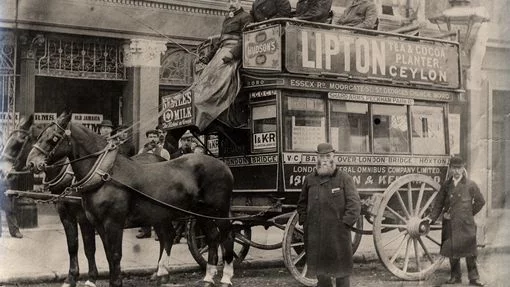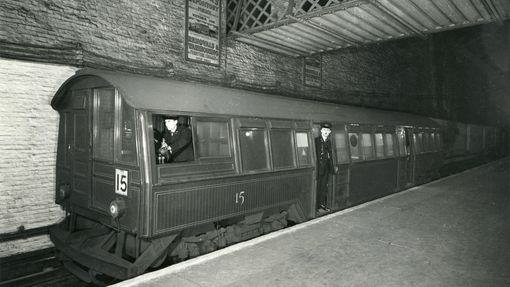
Transport stories
Introduction
Read about all of London’s modes of transport from riverboats in the 1800s to Tube trains, buses, bicycles and even cable cars of today
Discover more through our collection
Stories
‘Knifeboard’ buses were the first double-deckers. Learn more about the bus which ran in the 1870s and 1880s owned by Thomas Tilling, one of London’s biggest bus operators.
Learn how work on the south London Northern line Extension extension has also revealed surprising links between the Underground and the area’s queer history.
During the 1880s, the Metropolitan Railway began to commercially exploit land adjacent to its lines, mostly in the rural area north-west of London. Discover the story of Metro-land.
Read the story of why London buses are red
Winter weather presents numerous challenges for a public transport system, from snow on the tracks to icy roads and station platforms. Learn how LT kept London moving in winter.
Here we focus on ten road vehicles that have interesting stories to tell about how travel in the capital has changed.
The world’s first underground railway opened in London in 1863, as a way of reducing street congestion. Here is a very short history of the Underground.
The Metropolitan line is the oldest underground railway in the world. The Metropolitan Railway opened in January 1863 and was an immediate success, though its construction took nearly two years and caused huge disruption in the streets. Read more about the Metropolitan line.
Buses have evolved from basic wooden open-topped vehicles to highly sophisticated and intricately designed pieces of computerised technology. A short history of London’s buses.
As the second oldest Underground line, the District has a complicated history. Once the most sprawling of railways, with links and deals with many others. Read more about the District line.
During Queen Victoria's reign (1837-1901), London's population grew at an astonishing rate. London’s centre became increasingly congested. Read more about public transport in Victorian London – on the surface.
London’s population was about 1.7 million when Queen Victoria was crowned in 1837. Mainline railways in the 1840s and 1850s brought even more people into the Capital. Traffic congestion was reaching crisis point and radical solutions were needed. Read more about public transport in Victorian London – underground
Learn how competition fostered further developments in the story of London buses between the wars, 1918 – 1939.
At the start of the nineteenth century there were no buses or railways in London. The city was compact, and its narrow streets crowded. Learn how George Shillibeer, a coachbuilder and stable keeper and the London General Omnibus Company shaped London’s horse bus era.
In 2000 local government returned to London after a 14-year lapse. The new Greater London Authority took control of a new broader public transport organisation, Transport for London (TfL). Learn more about buses in the TfL era.
The Northern line serves some of the busiest commuter routes on the Underground, joining the suburbs of north and south London to the West End and the City. Read about the history of the Northern line.
When the First World War broke out, the era of the horse bus drew to a close. London’s largest bus operator, the London General Omnibus Company (LGOC), had replaced all its horse buses with motor buses by 1912. Learn how London buses played an important role during the First World War.
The Victoria line was the first deep-level Underground line to be built across central London for more than 50 years. Read more about the Victoria line.
London’s second tube railway is also its smallest, with only two stations and a name that tells you most of what you need to know. Read more about the Waterloo & City line.
The original Hammersmith & City line opened in 1864 and now serves 29 stations. It includes some of the oldest sections of the Underground, but since 2019 it has been controlled by the most modern Automatic Train Control technology. Read more about the Hammersmith & City line.
Discover the Underground lines
Other stories
Browse stories by category
From the logo to the map and posters to moquette, London’s transport design is known across the world. Discover the stories behind them here.
Stories about the marvels of engineering that have kept Londoners moving - from buses and trains to escalators and ticket machines.
Discover the fascinating stories of the people behind London’s transport – including directors, drivers, canteen workers, architects and designers.
London’s transport played an extraordinary part in both world wars. Find out more about the efforts of staff at home and overseas.


















































